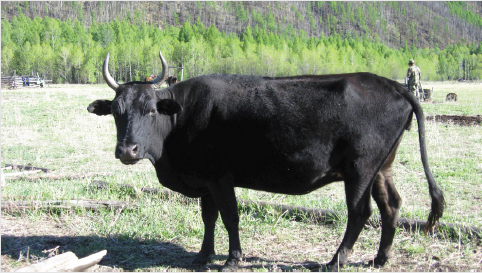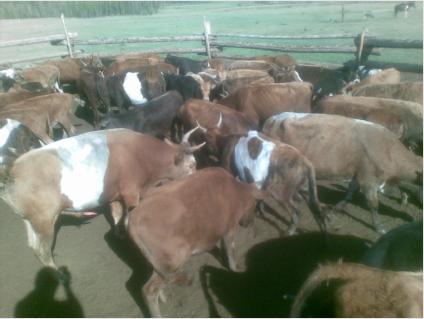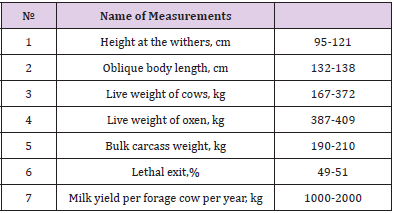Mini Review
In world practice, basically two methods of animal husbandry are used, pasture and stall. Both give the maximum effect if used for their intended purpose, considering the natural and climatic conditions of the area.
The second half of the XX century in the agrarian economy of the countries marked an increase in the breeding of “cultural” cattle breeds, which, in contrast to the aboriginal, are, as it were, more productive and technological. Therefore, animal husbandry based on local populations ceased to withstand competition. The historically established nomadic animal husbandry faded into the background. The local, aboriginal breeds of camels, horses, large and small ruminants, guard-shepherd dogs have disappeared and reached a critical number. However, in recent years, agricultural production, in particular the Republic of Buryatia, due to economic and environmental laws, is gradually leaning towards pasture animal husbandry. If in Eastern Siberia in the second half of the 20th century, stall-keeping cattle were mainly bred: cattle - Simmental breed, sheep - fine-fleece breeds, horses - heavy draft and trotting breeds, pigs, now more and more breeds of nomadic livestock began to be raised [1-3]. Through the efforts of enthusiasts, scientists, specialists and livestock breeders of Buryatia, the gene pool of three types of aboriginal cattle out of five traditionally bred in the region has been restored, these are camels, horses, sheep (Figure 1). Cattle and goats have not yet been recovered. These five livestock species have passed the toughest performance tests over thousands of years. In the long history of mankind, animals of the Buryat-Mongolian breed have repeatedly saved the people from hunger, cold, death in times of all kinds of warriors and cataclysms.
Buryat geneticists, breeders, livestock breeders created a horse of the Buryat breed in 1993 and a sheep of the Buubei breed in 2006 on the basis of the restored gene pool. Work is underway to restore the bactrian camels of the Trans-Baikal ecotype. However, it is still not possible to restore the gene pool of cattle and goats of the Buryat population. Aboriginal Buryat cattle (ABKRS), as an independent offspring, was formed under the conditions of Buryatia as a result of natural and artificial selection (Figure 2). Along with the natural and climatic conditions, the epizootic on the formation of the breed was influenced by herders [4,5]. Adaptive properties to the environment and economically useful traits of local livestock include:
• Short stature
• Energy
• Temperament
• Good Health
• Body Density
• The Ability to Store Enough Energy for a Long and Cold Winter
• Independently get food from under the snow
• High potency of breeding bulls
• The vitality of females.
Breeding experience shows that these cattle are not very susceptible to many diseases. For example, they rarely get sick with tuberculosis, leukemia, mastitis, etc. The growth of live weight of Buryat cattle occurs up to 9 years, and the growth energy in the first month and the next one and a half years is the highest. The fat content of milk is 4-6% [6-8]. The cost of care and maintenance of a native cow is two orders of magnitude less than that of a cultivated breed of dairy cows. The aboriginal Buryat Cattle, which belongs to pasture animal husbandry, gives products, in terms of 1 kg of live weight, 10-20% more than the Simmental breed of stall-keeping cattle (Table 1). The energy value of 1 kg of native Buryat cattle meat is 1.43 kg of Simmental cattle meat. The energy value of 1 kg of milk from an aboriginal Buryat cow is equal to 1.9 kg of milk from a Simmental cow. The cost of feeding, caring for and maintaining native livestock is two orders of magnitude less than livestock of cultivated breeds. Products from aboriginal animal husbandry are a priori of better quality, cheaper and more environmentally friendly, since animals breathe clean air around the clock, drink clean water, eat clean food, and are kept in a clean place that is not contaminated with parasites and microbes [9,10].
Depending on the economic tasks, ABKRS can be specialized in two directions:
• Dairy, with the achievement of milk yield with fat content of 4-6% up to 3.5 thousand liters and more per year for a forage cow.
• Meat, with a lethal output of ox meat up to 200 kg. and more for 18 months of content.
From direct crossing of ABKRS with a yak, you can get a hybrid - hainak and it will become possible to develop a new branch of cattle breeding - hainak breeding.
Hainak female productivity:
• Lives productively for 36 years
• Barrenness is practically not observed
• Kept year-round on pasture
• Fat content of milk 6-10% with a daily milk yield of 6 liters, excluding milk for a calf
• Slaughter yield of ox meat of 300 kg, for 18 months of keeping.
• Annual costs per head $ 3
When organizing beef cattle breeding with the use of native Buryat cattle, the economic efficiency of animal husbandry will significantly increase [11,12]. For the conservation of biological diversity, the gene pool of aboriginal animals is one of the greatest values on planet Earth.
References
- (1972) Agricultural encyclopedia. 3.
- (1961) Cattle breeding. Cattle. 1.
- Narmaev MB (1963) Kalmyk cattle and its improvement. Elista.
- Pomishin SB, Taishin VA, Lhasaranov BB (1993) Methodology for examining nomadic animals. Ulan-Ude.
- Tsydypov SG, Shirapdorzhiev Ts Zh, Lhasaranov BB (1994) Instructions for grading sheep of the Buryat coarse-wooled breed with the basics of breeding. Ulan-Ude.
- Lhasaranov BB (1994) Aboriginal sheep are cheaper. Siberian Land Far East p.9-10.
- Lhasaranov BB, et al. (1995) Studies of the phenetic structure of the population of the Buryat aboriginal sheep. // Tr.in-ta / BGSKhA 38: 117-123.
- Andrey A Yurchenko, Hans D Daetwyler, NikolayYudin, Robert D Schnabel, Christy J Vander Jagt, et al. (2018) Scans for signatures of selection in Russian cattle breed genomes reveal new candidate genes for environmental adaptation and acclimation. Sci Rep 8(1): 12984.
- Poulton SG, Ashton WM (1970) Astudy of the cosmoposition of clun forest ewe's milk. J Agric Sci 75: 121-132.
- Halliday R (1970) Protein concentrations in colastra from Finland Laudrace and Scottish Blacface ewe's during the first week of lactation and in sera from the ewe's and their lambs on the third day of lactation. J Agric Sci 74: 103-106.
- Corbet JL (1968) Variation in the yield and composition of milk of grazing Merino ewe's. Aust J Argic Res 19: 283-294.
- Barnicoat CR, Murray PF (1956) Milk selection studies with New Zealand Romney ewe's. J Agric Sci 48: 9-35.

 Mini Review
Mini Review


